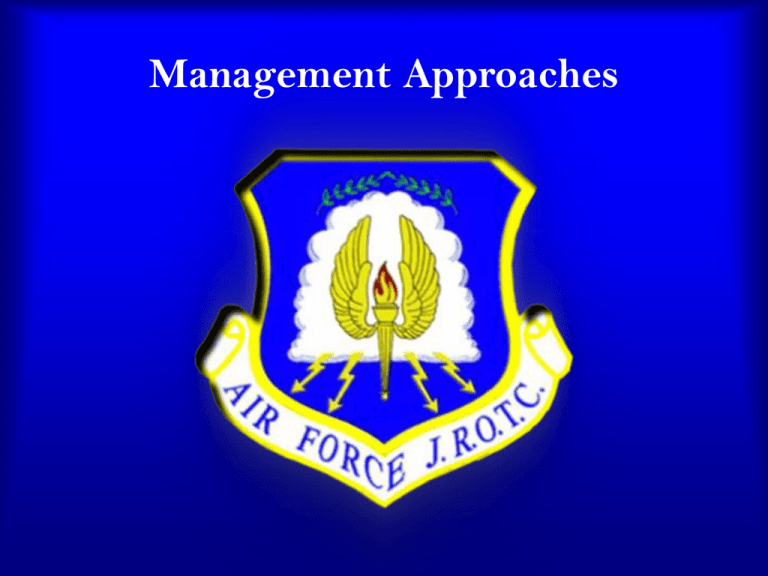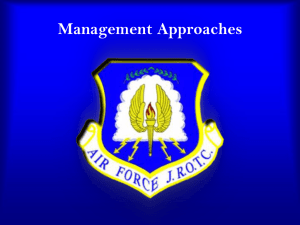
Management Approaches
Overview
Human resources approach to management
Quantitative approach to management
How social events shape management
approaches
Management approaches today
Chapter 2 Lesson 2
Quick Write
Do you have an optimistic or pessimistic view of
human nature? How does this view affect your
thinking about organizations?
Chapter 2 Lesson 2
Courtesy of Clipart.com
Human Resources Approach to
Management
Chapter 2 Lesson 2
Courtesy of Clipart.com
Robert Owen
Successful Scottish Businessman
Early Industrial Revolution
Saw practices that repulsed him
Children working in factories
Workers not making living wage
Sought to reduce suffering of
workers
Chapter 2 Lesson 2
Courtesy of Library of Congress
Hugo Munsterberg
Founder of Industrial Psychology
Called for psychological tests to better
match people with jobs
Today’s knowledge built on his ideas
Choosing, training, and motivating
employees
Designing jobs
Chapter 2 Lesson 2
Mary Parker Follett
One of first to consider organizations in terms
of individual and group behavior
Believed that the manager’s job was to
coordinate group efforts
Stressed the manager’s power with
employees, rather than power over them
Her ideas about motivation, leadership,
power, and authority remain current today
Chapter 2 Lesson 2
Chester Barnard
President of the New Jersey Bell
Telephone Company
Saw organizations as social systems that
needed human cooperation to work
rather than being impersonal
A company, in Barnard’s view, was a set
of people with interacting social
relationships
Chapter 2 Lesson 2
Chester Barnard
Suggested that the manager’s job was to
communicate and to get workers to put
out top effort
Realized that a successful business has
to win and keep the support of
investors, suppliers, customers, and
other outside stakeholders
Chapter 2 Lesson 2
The Hawthorne Studies
A series of studies during the 1920s and
1930s that provided new insights into
group norms and behaviors
Researchers studied the influence of
factors such as lighting intensity, job
redesign, length of the work day and
work week, rest periods, and pay
systems on productivity
Chapter 2 Lesson 2
The Hawthorne Studies
Discovered that group influences, group
standards, and group acceptance and security
affect behavior more than other factors
Brought renewed attention to human factors
Helped business owners get away from the
idea that workers were just like machines
Chapter 2 Lesson 2
The Human Relations Movement
Members of this group felt that a satisfied
worker would be a productive worker
Dale Carnegie, Abraham Maslow, and
Douglas McGregor were three people
leading the human relations movement
Views were rooted more in their personal
philosophies than in objective research
Chapter 2 Lesson 2
Courtesy of Library of Congress
Carnegie’s Four Points
Make others feel important by sincerely
appreciating their efforts
Make a good first impression
Win people over to your way of thinking
by letting them do the talking, being
sympathetic, and never telling a man that
he is wrong
Change people by praising their good
traits and letting offenders save face
Chapter 2 Lesson 2
Maslow’s Hierarchy of Needs
Selfactualization
Esteem
Social
Safety
Physiological
Chapter 2 Lesson 2
McGregor on Human Nature
Theory X is a negative view that assumes
people have little ambition, dislike work, shun
responsibility, and need close supervision to
get anything done
Theory Y, on the other hand, assumes human
beings like to work and can accept
responsibility and direct themselves
Chapter 2 Lesson 2
Role Play ~ Theory X or Y?
Your employee has just arrived late to
work for the third time in two weeks.
Role play how you will confront his or
her tardiness as a “Theory X” manager.
Role play how you will confront his or
her tardiness as a “Theory Y” manager.
Chapter 2 Lesson 2
Role Play ~ Theory X or Y?
Your employee grew frustrated with a rude
customer and walked away from him or her.
Role play how you will confront his or her
frustrated behavior as a “Theory X” manager.
Role play how you will confront his or her
frustrated behavior as a “Theory Y” manager.
Chapter 2 Lesson 2
Behavioral Science Theorists
Used the scientific method to study
organizational behavior
Tried to keep their personal beliefs out
of their work
Tried to do research others could
replicate
Chapter 2 Lesson 2
Human Resources Approach Today
Hundreds of different approaches
Researchers have generated a wealth of
studies that fairly accurately predict
behavior in organizations
Work affects the current understanding of
issues such as leadership, motivation, job
design, organizational culture, and
performance appraisal
Chapter 2 Lesson 2
Quantitative Approach
to Management
Chapter 2 Lesson 2
Courtesy of Photos.com
Management by the Numbers
Began during World War II
Efforts to find mathematical and statistical
solutions to military problems
After the war, businesses began to use these
number-crunching techniques on their own
problems
Chapter 2 Lesson 2
Courtesy of Comstock Images
Quantitative Techniques
Computer simulation ~ analyze the effect on a
company’s payroll if everyone receives a 10 percent
pay increase every year for 10 years
Optimization model ~ analyze the best price the
company can charge for its new product, to maximize
profit but not scare away potential customers
Critical path analysis ~ examine how long it will
really take to get a new product to market, with
separate teams working on different parts of the
project all at the same time
Chapter 2 Lesson 2
How Social Events Shape
Management Approaches
Chapter 2 Lesson 2
Courtesy of Photos.com
What Stimulated the
Classical Approach
Industrial revolution created a need to improve productivity
by making work places more efficient
Developing efficiencies reduced the cost of making products
~ allowed prices to go down and sales to go up
Selling more products allowed markets to grow and
companies to hire more people
As more people were earning a living wage and product
prices went down more people could afford to purchase
products like stoves and refrigerators
Scientific management raised the entire country’s standard
of living
Chapter 2 Lesson 2
What Stimulated the
Human Resources Approach
The classical view of workers as
machines and the Great Depression
stimulated the human resources
approach
The human resource approach
encouraged employers to treat
people like people, not machines
Encouraging workers was very
important during the tough times of
the Depression
Chapter 2 Lesson 2
Courtesy of Library of Congress
What Stimulated the
Quantitative Approach
World War II was the force behind the
quantitative approach
There was a need to develop mathematical
and statistical tools to apply to military
problems
When these efforts scored some
impressive successes, they soon found
applications in civilian life
Chapter 2 Lesson 2
Management Approaches Today
Chapter 2 Lesson 2
Taken from Fundamentals of Management, 5th Ed.
By Robbins/DeCenzo, p. 42
Pearson Prentice Hall, 2005
The Process Approach
Process approach considers the performance of
planning, organizing, leading, and controlling
as circular and continuous
Chapter 2 Lesson 2
Courtesy of Photos.com
The Systems Approach
The systems approach defines a system as
a set of related and interdependent parts
arranged in a manner that produces a
unified whole
An organization, with its management, is a
system that interacts with and depends on
its environment
Chapter 2 Lesson 2
The Systems Approach
Managers deal with an organization’s
stakeholders who are any group affected by
the organization’s decisions and policies
Government agencies, labor unions,
competing companies, employees,
suppliers, customers and clients, local
community leaders, and public interest
groups can all be stakeholders in the system
Chapter 2 Lesson 2
The Systems Approach
The manager’s job is to coordinate all these parts
(stakeholders) to achieve the organization’s goals
In the global economy, “environment” has a
broader meaning than ever, including broad labormarket trends (e.g., Asian workers receiving more
education and competing against American
workers), new technologies, changes in energy
and oil prices, and political developments are all
part of the global environment
Chapter 2 Lesson 2
What Do You Think?
How does the principal of the school
“coordinate all the parts to achieve the school’s
goals?” What are the parts the principal
coordinates?
Who are the stakeholders?
Is the government a stakeholder?
Are there labor unions?
Competing companies?
Employees? Suppliers?
Community Leaders?
Chapter 2 Lesson 2
A Contingency Approach
The contingency approach replaces
simpler principles of management and
integrates much of management theory
In management theory, contingency means
something like “variable”
How a manager manages depends (is
contingent) on the “variables” in a
particular organizational environment
Chapter 2 Lesson 2
Review
Owen, Munsterberg, Follett, and Barnard were
major historical contributors to the human
resource approach to management
The Hawthorne studies were a series of studies
during the 1920s and ’30s that provided new
insights into group norms and behaviors and
brought renewed attention to human factors of
production
Carnegie, Maslow, McGregor, and the behaviorists
were all key contributors to the human relations
movement
Chapter 2 Lesson 2
Review
The quantitative approach is management by the
numbers that seeks to find mathematical and
statistical solutions to problems
After the war, businesses began to use these numbercrunching techniques on their own problems
Quantitative techniques include computer
simulations, optimization models, and critical path
analysis
Chapter 2 Lesson 2
Review
The industrial revolution stimulated the classical
approach because of a need to improve
productivity by making work places more efficient
The classical view of workers as machines and the
Great Depression stimulated the human resources
approach
The need to find solutions to military problems
during World War II stimulated the quantitative
approach
Chapter 2 Lesson 2
Review
The process approach considers the performance
of planning, organizing, leading, and controlling
as circular and continuous
The systems approach defines a system as a set
of related and interdependent parts arranged in a
manner that produces a unified whole
The contingency approach suggests that how a
manager should manage depends (is contingent)
on the “variables” in a particular organizational
environment
Chapter 2 Lesson 2
Summary
Human resources approach to management
Quantitative approach to management
How social events shape management
approaches
Management approaches today
Chapter 2 Lesson 2
What’s Next…
Management and
the Economy
Chapter 2 Lesson 2
Courtesy of Clipart.com




